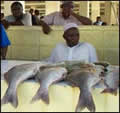       |
|
You are here > City > Life Style > Tanzanian Food Tanzanian staples include grain, fruit, and vegetables. Common meats are chicken, goat, beef, and lamb. A popular snack or energy food is kitumbua, a fried bread common in much of East Africa. Ugali, a stiff porridge made from maize meal, millet, sorghum, or cassava, is also eaten. Bananas are a staple in much of northern Tanzania-particularly around Lake Victoria and in the foothills of Kilimanjaro-and in the southwest around Mbeya and Lake Malawi. They are prepared in a variety of ways: roasted, fried, or made into a paste and mixed with meat and gravy. Rice is the staple of much of the coastal area and is often cooked with a variety of spices, including cloves, curry, cinnamon, cumin, and hot peppers, to make pilau. Ugali, rice, or bananas are commonly served with a stew of one or a combination of the following: beef, chicken, fish, goat, green leafy vegetables such as cabbage, Swiss chard, or spinach, beans, and cowpeas. Muslims do not eat pork or drink alcohol. Kivukoni Fish Market Kivukoni Fish Market has recently been rehoused in a new structure on Dar es Salaam's seafront. Boats deliver their catch at dawn directly to the market and a frantic fish fracas ensues. Wade in for red snapper, lobster, prawns, squid, barracuda and shellfish fresh from the Indian Ocean. Food is usually eaten with the right hand, and even when utensils are used, a bowl or basin of water is offered for washing hands before each meal. The left hand may be used when handling difficult foods, such as meat with bones, but not for taking food from a communal bowl or for putting food in the mouth. Eating from a communal dish is common, especially when eating ugali or rice. Some families along the Indian Ocean coast, as well as those in villages and towns along the three lakes-Lake Malawi, Tanganyika, and Victoria-sit on woven mats on the floor to eat meals. Muslims tend to sit cross-legged on these mats. Among Muslims, as well as some non-Muslims in rural areas, it is common for men and women to eat separately. When guests are invited, time is reserved for socializing both before and after dinner. It is therefore impolite to leave a home immediately after a meal. |
|







